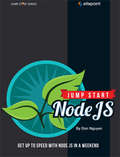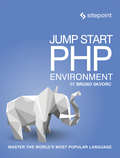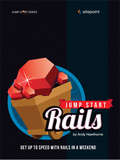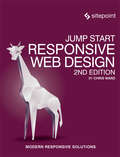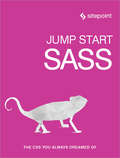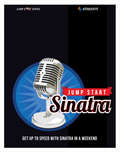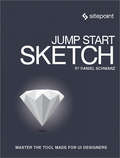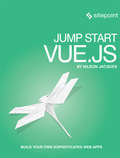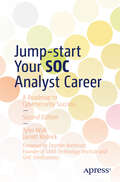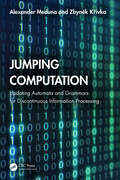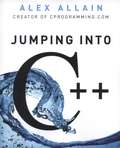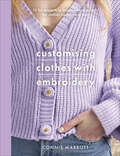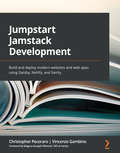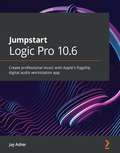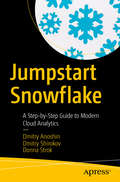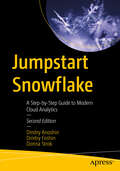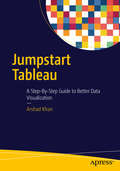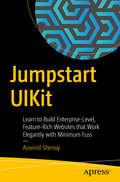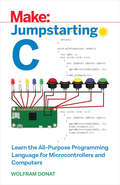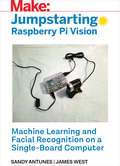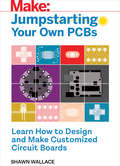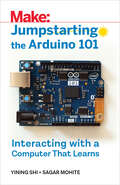- Table View
- List View
Jump Start Node.js: Get Up to Speed With Node.js in a Weekend
by Don NguyenNode.js is changing the way web apps are built. As Node.js apps are written in JavaScript, you can quickly and simply use your front-end skills to develop staggeringly fast, scalable real-time web applications. Read this book and, in a weekend, you’ll learn how to: Develop a complete working Node.js application - from start-to-finishDeploy your new application to a production serverScale your projects quickly and cheaply PLUS discover how to use Twitter Bootstrap, MongoDB and Back-bone.js to create fancy web apps, extend their storage, and dy-namically update them.
Jump Start PHP Environment: Master the World's Most Popular Language
by Bruno SkvorcMany entry level PHP developers want a quick path to glory, a shortcut to "knowing PHP." Too many books and tutorials go straight into a pre-made, awful environment that just wants you to code, with no regard for security, version control, or other absolutely essential practices. This book is aimed at the absolute beginner who wants to start learning PHP, but aims to set you up with a thorough understanding of what makes for a good, modern, adaptable PHP environment before you start diving into PHP itself.This book will cover a the essential building blocks of a good PHP environment, including covering topics such as:The anatomy of a web requestThe importance of a good IDEUsing Composer for package managementVersion control with Git and GitHubDeployment and hosting optionsUsing virtual machinesBuild a sample app from scratch and deploy it -- the right wayAnd much more!
Jump Start PHP: Get Up to Speed With PHP in a Weekend
by Callum HopkinsGet a Jump Start on PHP today! PHP is a key server-side technology in web development, enabling you to quickly and simply develop interactive, usable and engaging websites and applications. In just one weekend with this SitePoint book, you'll learn how to: Install all of the software you need to begin developing PHP applicationsUnderstand PHP functions and syntaxBuild a complete, working PHP application from scratch: a simple social networking app Plus you'll discover how to use modern techniques such as MVC and REST
Jump Start Rails: Get Up to Speed With Rails in a Weekend
by Andy HawthorneJump Start Rails provides you with a fun and yet practical introduction to Rails, an incredibly popular framework that makes it possible to quickly develop incredibly powerful web applications with Ruby. This short book covers Rails 4, the latest version of the framework, and while it's not intended to be a completely comprehensive Rails guide or an in-depth Ruby tutorial, it will quickly get you up to speed with Rails and give you the confidence to start experimenting on your own.The book is built around a real-life example project: a personal portfolio site. It's a fun and easily understandable project that is used to demonstrate the concepts outlined in the book in a practical way.This is a clear, approachable and very easy-to-follow book that will get you to to speed with Rails in no time.
Jump Start Responsive Web Design: Modern Responsive Solutions
by Chris WardIt used to be so simple. You made a website or application to work on a 15" monitor and, incompatibilities between browsers aside, you were done. Then along came mobile phones with web browsers and they ruined all our easy lives. Worse than that, people loved browsing the web on them! Fortunately, by using responsive web design techniques, you can use one set of HTML, CSS and JavaScript, and display appropriate elements in an appropriate way to suit each platform. In Jump Start Responsive Web Design, you'l learn responsive techniques to make your designs look magnificent on any device, future-proof them, and reduce development time and budget. RWD helps you deal with the very real problem of not knowing where and how your application will be used. Completely overhauled for its second edition, this book covers: What does responsive really mean?Semantic page structureGrid systemsResponsive Images and mediaMedia queriesResponsive content
Jump Start Sass: Get Up to Speed With Sass in a Weekend
by Hugo Giraudel Miriam SuzanneGet a Jump Start on the popular CSS preprocessor Sass today! Using Sass, you can write your stylesheets in a more concise, dynamic, and readable way, and cut down many of the tedious repetitive tasks that come with writing vanilla CSS. Sass simplifies your stylesheets, adding some useful features missing from CSS. Most importantly, Sass will save you time. This book provides a thorough introduction to Sass for the beginner. In it, you'll learn: What preprocessors are and how they can be usefulInstallation and getting startedVariables, mixins, and functionsLoops and conditionsNestingExtendWarnings & errorsProject architectureThe Sass ecosystemAnd more!
Jump Start Sinatra: Get Up to Speed With Sinatra in a Weekend
by Darren JonesThis short SitePoint book provides readers with a fun and yet practical introduction to Sinatra, a framework that makes web development with Ruby extremely simple. It's not intended to be a completely comprehensive guide to the framework or an in-depth Ruby tutorial, but will quickly get you up to speed with Sinatra and give you the confidence to start experimenting on your own.The book is built around a real-life example project: a content management system. It's a fun and easily understandable project that is used to demonstrate the concepts outlined in the book in a practical way.This is a clear, approachable and very easy-to-follow book that will get you to to speed with Sinatra in no time.
Jump Start Sketch: Master the Tool Made for UI Designers
by Daniel SchwarzGet a Jump Start on the up and coming power tool on the design scene, Sketch! Sketch is fast becoming a favorite tool of modern web designers. With a simple, clean UI, and a raft of powerful features, such as intuitive grids, unlimited artboards, and granular export, Sketch is a great tool for web design; it's easy to see why so many top designers are adding it to their toolbox. This book provides a rapid and practical introduction to using Sketch for web design. If you're currently a Photoshop user, you'll quickly understand how Sketch can supercharge your design process. See how Sketch compares to Photoshop, and when to use one over the otherGet to grips with Sketch's UIUse Sketch's built-in layout gridAdd plugins to Sketch to boost functionalityExport your designs into ready-to-use HTML and CSSAnd much more!
Jump Start Vue.js
by Nilson JacquesGet up to speed with Vue.js in a weekend! Since its release in 2014, Vue.js has seen a meteoric rise to popularity and is now considered one of the primary front-end frameworks, and not without good reason. Its component-based architecture was designed to be flexible and easy to adopt, making it just as easy to integrate into projects and use alongside non-Vue code as it is to build complex client-side applications. This short book is ideal for front-end developers who need a rapid introduction to Vue.js. It covers: Basic concepts: how Vue works, tempmlates, and reactive dataComponents: custom components, events and slotsState management: Vuex, mutations, actionsRoutes: creating routes, links and route guardsNuxt.jsAnd much more!
Jump-start Your SOC Analyst Career: A Roadmap to Cybersecurity Success
by Tyler Wall Jarrett RodrickThe frontlines of cybersecurity operations include many unfilled jobs and exciting career opportunities. A transition to a security operations center (SOC) analyst position could be the start of a new path for you. Learn to actively analyze threats, protect your enterprise from harm, and kick-start your road to cybersecurity success with this one-of-a-kind book.Authors Tyler Wall and Jarrett W. Rodrick carefully and expertly share real-world insights and practical tips in Jump-start Your SOC Analyst Career. The lessons revealed equip you for interview preparation, tackling day one on the job, and setting long-term development goals. This book highlights personal stories from five SOC professionals at various career levels with keen advice that is immediately applicable to your own journey. The gems of knowledge shared in this book provide you with a notable advantage for entering this dynamic field of work. The recent surplus in demand for SOC analysts makes Jump-start Your SOC Analyst Career a must-have for aspiring tech professionals and long-time veterans alike. Recent industry developments such as using the cloud and security automation are broken down in concise, understandable ways, to name a few. The rapidly changing world of cybersecurity requires innovation and fresh eyes, and this book is your roadmap to success.What You Will Learn Understand the demand for SOC analystsKnow how to find a SOC analyst job fastBe aware of the people you will interact with as a SOC analystBe clear on the prerequisite skills needed to be a SOC analyst and what to studyBe familiar with the day-to-day life of a SOC analyst, including the tools and language usedDiscover the rapidly emerging areas of a SOC analyst job: the cloud and security automation Who This Book Is For Anyone interested in starting a career in cyber security: recent graduates, IT professionals transitioning into security, veterans, and those who are self taught
Jump-start Your SOC Analyst Career: A Roadmap to Cybersecurity Success
by Tyler Wall Jarrett RodrickThe frontlines of cybersecurity operations include many unfilled jobs and exciting career opportunities.A transition to a security operations center (SOC) analyst position could be the start of a new path for you. Learn to actively analyze threats, protect your enterprise from harm, and kick-start your road to cybersecurity success with this one-of-a-kind book. Authors Tyler E. Wall and Jarrett W. Rodrick carefully and expertly share real-world insights and practical tips in Jump-start Your SOC Analyst Career. The lessons revealed equip you for interview preparation, tackling day one on the job, and setting long-term development goals.This book highlights personal stories from five SOC professionals at various career levels with keen advice that is immediately applicable to your own journey. The gems of knowledge shared in this book provide you with a notable advantage for entering this dynamic field of work. The recent surplus in demand for SOC analysts makes Jump-start Your SOC Analyst Career a must-have for aspiring tech professionals and long-time veterans alike. Recent industry developments such as using the cloud and security automation are broken down in concise,understandable ways, to name a few. The rapidly changing world of cybersecurity requires innovation and fresh eyes, and this book is your roadmap to success. New to this edition: This revised edition includes three entirely new chapters: Roadmap to Cybersecurity Success, The SOC Analyst Method, and ChatGPT for SOC Analysts. In addition, new material includes a substantially revised Cloud chapter, revised pre-requisite skills, and minor revisions to all chapters to update data. What You Will Learn • Understand the demand for SOC analysts • Know how to find a SOC analyst job fast • Be aware of the people you will interact with as a SOC analyst • Be clear on the prerequisite skills needed to be a SOC analyst and what to study • Be familiar with the day-to-day life of a SOC analyst, including the tools and language used • Discover the rapidly emerging areas of a SOC analyst job: the cloud • and security automation • Explore the career paths of a SOC analyst • Discover background-specific tips for your roadmap to cybersecurity success • Know how to analyze a security event • Know how to apply ChatGPT as a SOC analyst Who This Book Is For Anyone interested in starting a career in cybersecurity: recent graduates, IT professionals transitioning into security, veterans, and those who are self-taught.
Jumping Computation: Updating Automata and Grammars for Discontinuous Information Processing
by Alexander Meduna Zbyněk KřivkaJumping Computation: Updating Automata and Grammars for Discontinuous Information Processing is primarily a theoretically oriented treatment of jumping automata and grammars, covering all essential theoretical topics concerning them, including their power, properties, and transformations. From a practical viewpoint, it describes various concepts, methods, algorithms, techniques, case studies and applications based upon these automata and grammars. In today’s computerized world, the scientific development and study of computation, referred to as the theory of computation, plays a crucial role. One important branch, language theory, investigates how to define and study languages and their models, which formalize algorithms according to which their computation is executed. These language-defining models are classified into two basic categories: automata, which define languages by recognizing their words, and grammars, which generate them. Introduced many decades ago, these rules reflect classical sequential computation. However, today’s computational methods frequently process information in a fundamentally different way, frequently “jumping” over large portions of the information as a whole. This book adapts classical models to formalize and study this kind of computation properly. Simply put, during their language-defining process, these adapted versions, called jumping automata and grammars, jump across the words they work on. The book selects important models and summarizes key results about them in a compact and uniform way. It relates each model to a particular form of modern computation, such as sequential, semi-parallel and totally parallel computation, and explains how the model in question properly reflects and formalizes the corresponding form of computation, thus allowing us to obtain a systematized body of mathematically precise knowledge concerning the jumping computation. The book pays a special attention to power, closure properties, and transformations, and also describes many algorithms that modify jumping grammars and automata so they satisfy some prescribed properties without changing the defined language. The book will be of great interest to anyone researching the theory of computation across the fields of computer science, mathematics, engineering, logic and linguistics.
Jumping Into C++
by Alex AllainWant to learn to code? Want to learn C++? Struggling to follow your lecturer or books and tutorials written for experts? You're not alone. As a professional C++ developer and former Harvard teaching fellow, I know what you need to know to be a great C++ programmer, and I know how to teach it, one step at a time. I know where people struggle, and why, and how to make it clear. I cover every step of the programming process, including: Getting the tools you need to program and how to use them Basic language feature like variables, loops and functions How to go from an idea to code A clear, understandable explanation of pointers Strings, file IO, arrays, references Classes and advanced class design C++-specific programming patterns Object oriented programming Data structures and the standard template library (STL) Key concepts are reinforced with quizzes and over 75 practice problems.
Jumping for Joy: The History of Platform Video Games
by Chris ScullionThe platformer is one of the most well-loved video game genres ever, having entertained players for over 40 years. Jumping For Joy is a celebration of everything platform games have to offer, spanning their entire history. The first part of the book is a complete guide to every platform game starring Mario, Nintendo’s mascot and the most popular video game character of all time. With nearly 80 games featured in this section, it’s the definitive history of a true gaming hero. There are always two sides to every story, though, so the second part of the book focuses on every one of the 50+ platformers starring Sonic the Hedgehog, Mario’s former rival. After this it’s the book’s main course: a huge 100-page section detailing 50 other iconic and notable platform games covering the entire history of gaming, from the days of the Atari 2600 and ZX Spectrum all the way up to the Nintendo Switch, PS5 and Xbox Series X/S. Whether you’re a long-time veteran of platform gaming or a newcomer who wants to learn more about one of the most entertaining genres in video games, this is the perfect book for you. And there are some bad jokes in there too, if that’s your thing.
Jumpstart Jamstack Development: Build and deploy modern websites and web apps using Gatsby, Netlify, and Sanity
by Christopher Pecoraro Vincenzo Gambino Magnus Kongsli HillestadLeverage Jamstack principles, techniques, and best practices to build dynamic websites and web apps focused on speed, security, and accessibilityKey FeaturesUnderstand how JavaScript integrates with reusable application program interfaces (APIs) and browser markup to build a serverless web applicationGain a solid understanding of static site development with Gatsby and its importance in JamstackFind out how to deploy a Jamstack event website directly from GitHub using NetlifyBook DescriptionJamstack (JavaScript, API, and Markup) enables web developers to create and publish modern and maintainable websites and web apps focused on speed, security, and accessibility by using tools such as Gatsby, Sanity, and Netlify. Developers working with Jamstack will be able to put their knowledge to good use with this practical guide to static site generation and content management. This Jamstack book takes a hands-on approach to implementation and related methodologies that will have you up and running with modern web development in no time.Complete with step-by-step explanations of essential concepts, practical examples, and self-assessment questions, you'll begin by building an event and venue schema structure, and then expand the functionality, exploring all that the Jamstack has to offer. You'll learn how an example Jamstack is built, build structured content using Sanity to create a schema, use GraphQL to expose the content, and employ Gatsby to build an event website using page and template components and Tailwind CSS Framework. Lastly, you'll deploy the website to both, a Netlify server and the Microsoft Static Web Apps Service, and interact with it using Amazon Alexa.By the end of this book, you'll have gained the knowledge and skills you need to install, configure, build, extend, and deploy a simple events website using Jamstack.What you will learnDiscover the Jamstack approach and build speedy, secure, and accessible websites and web apps with its component technologiesBuild an events website by using the Jamstack and the Gatsby static site generatorCreate and modify your templates and pages to build creative web appsBuild, modify, and extend structured content schemas in SanityUnderstand Gatsby plugins, project structure, and files, and how it can be used to build Jamstack appsFind out how GatsbyJS uses GraphQL to source contentWho this book is forThis book is for web developers looking to implement Jamstack practically. JavaScript developers who want to build modern speedy and secure web apps will also find this book useful. Familiarity with JavaScript and Database programming is assumed.
Jumpstart Logic Pro X 10.5: Create professional music with Apple's flagship digital audio workstation app
by Jay AsherA practical guide that takes you from understanding the fundamentals of Logic Pro X to discovering professional music creation techniques with an easy-to-follow approachKey FeaturesExplore the world of music production by getting up to speed with Logic Pro XUnderstand the fundamentals of music production such as recording, editing, and adding effects to musicLearn to produce virtual sounds and music effects to enhance your music and create a final master from a raw music fileBook DescriptionLogic Pro X is Apple's flagship application for music creation, found in many professional music studios across the globe. It is a powerful digital audio workstation that comes with all the software tools that you need to create music that sounds great. In the latest version, Logic Pro X 10.5, Apple has added impressive features to what was already a full package of tools, loops, FX plug-ins, and software instruments.Providing a comprehensive introduction if you're new to Mac computer music creation, this practical guide will show you how to use Logic Pro X and have you up to speed in no time.You'll not only understand what Apple's Logic Pro X software can do but also get hands-on with using it to accomplish various musical tasks. The book starts by getting you up and running with the basic terminologies. As you progress, you'll explore how to create audio and MIDI musical parts. To build on your knowledge further, the book will guide you through developing an automated mix. In addition to this, you'll learn how to bounce mixes and audio files for distribution.By the end of this book, you'll be well-versed with Logic Pro X and have the skills you need to create professional-quality music.What you will learnGet to grips with Audio and MIDI and how they are different, along with covering Apple LoopsRecord and edit audio, such as your voice or guitarCreate and edit MIDI parts, using Logic Pro X's software instrumentsDevelop realistic drums and electronic drums with Logic Pro X 10.5's amazing DrummerExplore the new Step Sequencer, Live Loops, and Quick Sampler that are now included with version 10.5Edit your arrangement and prepare the parts for mixingDiscover the principles of good mixing, including automation, pre-mastering, and final bouncingWho this book is forThis book is for musicians, songwriters, and music producers who want to learn Logic Pro X from scratch with the help of expert guidance. A basic understanding of music theories such as chords and notes is highly recommended before you get started. This Logic Pro X book also assumes that you'll be working on a Mac.
Jumpstart Snowflake: A Step-by-Step Guide to Modern Cloud Analytics
by Dmitry Anoshin Dmitry Shirokov Donna StrokExplore the modern market of data analytics platforms and the benefits of using Snowflake computing, the data warehouse built for the cloud. With the rise of cloud technologies, organizations prefer to deploy their analytics using cloud providers such as Amazon Web Services (AWS), Microsoft Azure, or Google Cloud Platform. Cloud vendors are offering modern data platforms for building cloud analytics solutions to collect data and consolidate into single storage solutions that provide insights for business users. The core of any analytics framework is the data warehouse, and previously customers did not have many choices of platform to use. Snowflake was built specifically for the cloud and it is a true game changer for the analytics market. This book will help onboard you to Snowflake, present best practices to deploy, and use the Snowflake data warehouse. In addition, it covers modern analytics architecture and use cases. It provides use cases of integration with leading analytics software such as Matillion ETL, Tableau, and Databricks. Finally, it covers migration scenarios for on-premise legacy data warehouses. What You Will Learn Know the key functionalities of SnowflakeSet up security and access with clusterBulk load data into Snowflake using the COPY commandMigrate from a legacy data warehouse to Snowflakeintegrate the Snowflake data platform with modern business intelligence (BI) and data integration tools Who This Book Is For Those working with data warehouse and business intelligence (BI) technologies, and existing and potential Snowflake users
Jumpstart Snowflake: A Step-by-Step Guide to Modern Cloud Analytics
by Dmitry Anoshin Donna Strok Dmitry FoshinThis book is your guide to the modern market of data analytics platforms and the benefits of using Snowflake, the data warehouse built for the cloud. As organizations increasingly rely on modern cloud data platforms, the core of any analytics framework—the data warehouse—is more important than ever. This updated 2nd edition ensures you are ready to make the most of the industry&’s leading data warehouse. This book will onboard you to Snowflake and present best practices for deploying and using the Snowflake data warehouse. The book also covers modern analytics architecture, integration with leading analytics software such as Matillion ETL, Tableau, and Databricks, and migration scenarios for on-premises legacy data warehouses. This new edition includes expanded coverage of SnowPark for developing complex data applications, an introduction to managing large datasets with Apache Iceberg tables, and instructions for creating interactive data applications using Streamlit, ensuring readers are equipped with the latest advancements in Snowflake's capabilities. What You Will Learn Master key functionalities of Snowflake Set up security and access with cluster Bulk load data into Snowflake using the COPY command Migrate from a legacy data warehouse to Snowflake Integrate the Snowflake data platform with modern business intelligence (BI) and data integration tools Manage large datasets with Apache Iceberg Tables Implement continuous data loading with Snowpipe and Dynamic Tables Who This Book Is For Data professionals, business analysts, IT administrators, and existing or potential Snowflake users
Jumpstart Tableau
by Arshad KhanThis book simplifies the use of Tableau software functionality for novice users so that they can create powerful data visualizations easily and quickly. Since it is often very difficult and expensive to provide external training on BI tools, this book aims to equip the reader with the resource they need to do it themselves. Jumpstart Tableau covers the basic reporting and analysis functions that most BI users perform in their day-to-day work. These include connecting to a data source, working with dimensions and measures, developing reports and charts, saving workbooks, filtering, swapping, sorting, formatting, grouping, creating hierarchies, forecasting, exporting, distributing, as well developing various chart types. Each exercise in Jumpstart Tableau provides screenshots that cover every step from start to finish. The exercises are based on a comprehensive sample Excel-based data source that Tableau Software (version 9) has provided, which makes it very easy to duplicate the exercises on the real software. In addition, the book: Enables readers to develop reports, queries and visualizations Perform data analysis Execute each function in a step-by-step manner Provides the basic hands-on ability which can enable users to work up to more advanced and complex Tableau functionality Shows how to integrate individual development of content, such as tables/charts and visualizations. , onto a dashboard for an effective presentation What You'll Learn How to connect to data sources How to develop reports How to develop visualizations How to perform analysis functions (e. g. , filtering, drilldown, sorting, grouping, forecasting, etc. ) How to save visualizations in different formats and distribute them How to develop dashboards and their content Who this book is for Novice Tableau users, BI end users, as well as developers and business analysts. Also, students in university courses on dashboards and data visualization as well as BI and data analysis can quickly get up to speed with Tableau tools and use them for implementing the hands-on projects associated with these courses.
Jumpstart UIKit: Learn to Build Enterprise-Level, Feature-Rich Websites that Work Elegantly with Minimum Fuss
by Aravind ShenoyLearn to build modern, sleek, and powerful websites quickly and easily with UIKit, an open-source, responsive, and lightweight framework. This book reveals the massive potential of this amazing framework to help you prototype, develop, and customize your web projects as per your business requirementsResponsive web design is imperative nowadays as mobile sites become the de-facto standard. UIKit makes front-end design easier and helps speed up the development process significantly. You can build enterprise-level, feature-rich websites that work elegantly with a wide range of different device sizes and resolutions with minimum fuss.You'll play with the mobile-first grid component and an expansive set of intuitive CSS elements. UIKit simplifies the difficult task of crafting intricate and robust websites. Instead of loads of theory, this good read will help you get comfortable with the various utilities using comprehensive coding examples in an easy-to-understand manner. What You'll Learn Set up the UIKit's required build tools to get startedCreate a fully responsive, fluid, and nested grid layoutUse UIKit to take your first steps in responsive web designPlay with the wide-range of CSS components and elementsWork with design web elements such as Navigation, Cards, Modals, Forms, and Accordion. Who This Book Is For This book is aimed at newbies and beginners, who are keen to build responsive websites using the solid UIkit framework. It can also be a quick reference for web designers, who are acquainted with or use the UIkit toolset for their important projects.
Jumpstarting C
by Wolfram DonatAll Make Jumpstart books provide a quick way for makers to "jumpstart" their knowledge of a certain topic.Jumpstarting C takes the reader on a 50-page journey, from installing C on a Raspberry Pi, to creating their first "Hello World" program in C, to building and programming a handheld 4-color memory game using C, pushbuttons and LEDs.
Jumpstarting Javascript
by Lynn BeighleyAll Make Jumpstart books provide a quick way for readers to "jumpstart" their knowledge of a certain topic.In 50 intense pages, Jumpstarting JavaScript shows makers how to install the Node.js environment on a Raspberry Pi, how to use Node.js to turn their Raspberry Pi into a self-contained web server, and how to get that web server to send a tweet.
Jumpstarting Raspberry Pi Vision
by Sandy Antunes James WestLearn how to teach a Single Board Computer like a Raspberry Pi to recognize individual faces, using the latest Machine Learning techniques.
Jumpstarting Your Own PCB: Learn How to Design and Make Customized Circuit Boards
by Shawn WallaceLearn to make your own printed circuit boards, using open source software and inexpensive manufacturing techniques!
Jumpstarting the Arduino 101
by Yining Shi Sagar MohiteGet up and running quickly with the new Jumpstarting ebook series from Make:. The Arduino 101 is a low-power board that includes not only Bluetooth LE capabilities but an on-board 6-axis accelerometer/gyroscope for exciting real-world-connected projects.
